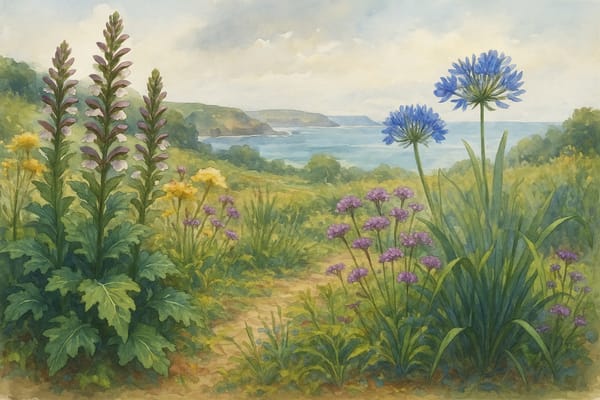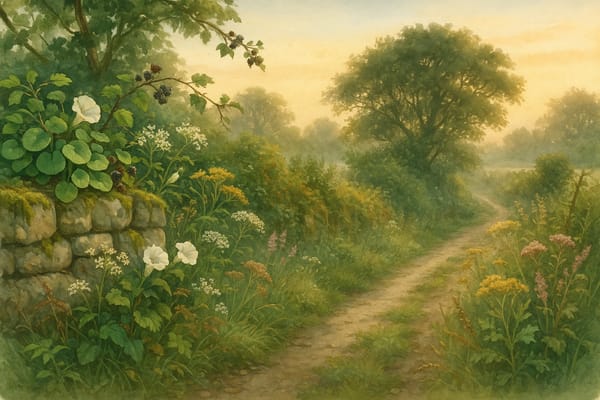Across Cornwall, a quiet revolution is blooming — one not built from novelty or fashion, but rooted deep in tradition. As the climate shifts and urban spaces seek renewal, gardeners, designers, and communities are turning to the plants of the past to shape the landscapes of the future. In this blend of old and new, Cornish heritage varieties — from orchard apples to coastal wildflowers — are stepping into the spotlight not just as nostalgic treasures, but as climate-smart, biodiversity-rich allies in modern garden and urban design.
This is the story of how Cornwall’s native and heritage plants are being adapted for the changing world around us — and how they’re helping shape more resilient, beautiful, and meaningful landscapes across the Duchy.
The plants of Cornwall are more than just greenery — they are cultural markers, ecological keystones, and time-tested survivors of some of the UK's most unique growing conditions. Heirloom vegetables, old apple cultivars, and native wildflowers have evolved and been selected over centuries for their ability to thrive in the region’s coastal gales, salty air, and unpredictable rainfall.
Now, these same traits — once seen as quaint or purely nostalgic — are gaining new relevance. Whether in a modern cottage garden, a community allotment, or a pollinator-rich verge in Truro, these plants are offering low-input, high-value solutions for gardeners contending with drought, flooding, and habitat loss.
Heritage varieties like Cornish Aromatic apples or ancient daffodil cultivars are being grown alongside urban wildflower meadows and “herbal leys,” creating a powerful intersection between the edible, the ornamental, and the ecologically essential.
Hardy Heroes in a Changing Climate
At the heart of this transformation is resilience. Native Cornish plants — especially those adapted to cliffs, heathlands, and meadows — have developed remarkable survival mechanisms in response to Cornwall’s variable climate. Many possess waxy, hairy, or silver-toned foliage to conserve moisture and reflect heat. Others, like thrift (Armeria maritima) and sheep’s-bit (Jasione montana), anchor into sandy soils and withstand both summer droughts and winter storms.
Urban greening projects across the county now routinely feature these coastal and native plants. In towns like Penzance, Redruth, and Newquay, road verges and public parks have been seeded with native wildflower mixes that offer more than beauty — they absorb water, support pollinators, and require less maintenance than traditional bedding displays.
Flood-tolerant species, too, have a role to play. Trees like sessile oak and willow stabilise riverbanks and hedgerows, their deep roots increasing water infiltration and reducing surface runoff. In low-lying areas, planting native wetland plants helps hold water in the soil and filter pollutants, restoring balance to disrupted hydrological systems.
Pollinators, People, and Public Places
The resurgence of heritage and wild plants is not just practical — it’s poetic. Research from the University of Exeter and Cornwall Council has shown that sowing urban spaces with native plants like oxeye daisy (Leucanthemum vulgare), cat’s ear (Hypochaeris radicata), and knapweed (Centaurea nigra) leads to dramatic increases in pollinators, especially solitary bees and hoverflies. These blooms, familiar from Cornish pastures and field edges, have found new homes in schools, parks, churchyards, and even housing developments.
Projects like the “Making Space for Nature” initiative have enhanced over 78 hectares of green space in Cornish towns. The blend of heritage-inspired design with high ecological function has transformed sterile lawns into buzzing hubs of life — while also reconnecting people with the rhythms and colours of the regional landscape.
Community pathways — like the “Pollinator Pathmaker” led by the Eden Project — now link gardens, verges, and wild corners into living corridors. These corridors stitch together ecology and identity, transforming urban terrain into habitat-rich networks grounded in Cornish heritage.
Heritage Apples in the City
Among the most charismatic characters in this movement are Cornwall’s heritage fruit trees. Cultivars like the Cornish Gilliflower — revered for its spicy perfume and high sugar content — are finding renewed purpose in modern orchards and edible urban gardens.
Their genetic traits, honed over generations, make them surprisingly resilient. Deep roots, diverse flowering times, and tolerance to disease make these apples ideal for unpredictable climates. But beyond their resilience, they are storytellers — holding centuries of cultivation history in their DNA and in their flavour.
Small-scale orchard revival projects in places like Penryn and St Austell are showing how these trees can bring both food security and cultural meaning to contemporary landscapes. Each grafted branch becomes a bridge between past and future, soil and society.
Living Landscapes, Cultural Memory
What makes this moment particularly powerful is not just the shift in plant selection, but the values behind it. Cornwall’s approach increasingly reflects a biocultural philosophy — one that sees plants not merely as functional components but as living archives of knowledge, culture, and place.
Planting a native foxglove or heirloom broad bean becomes an act of memory as well as cultivation. These plants carry stories — of miners’ gardens, fishing village hedgerows, and farmstead borders where vegetables and wildflowers grew side by side. Today, those same species are being adapted into new designs that respect their origins while embracing their modern relevance.
And with each new planting — in a housing estate, a school garden, a care home, or a wildlife verge — that heritage is renewed, no longer frozen in time but active and adaptive.
Designing with Diversity
Modern landscape architects, community groups, and gardeners are embracing this adaptive ethos in innovative ways. Case studies like the “Wild Child Cornwall Garden,” presented at public events, showcase how bold planting with heritage species can be fun, resilient, and rich in biodiversity.
The use of structural and sensory plants — like Acanthus mollis, Verbena bonariensis, and Salvia amistad — creates layers of texture and life, especially when paired with native daisies, coastal grasses, and old-fashioned herbs. These gardens blur the lines between ornamental and ecological, creating spaces that feed bees, delight children, and soothe weary urbanites.
And at the larger scale, Cornwall’s Pollinator Action Plan and Natural Flood Management schemes are institutionalising these strategies — embedding heritage species into planning frameworks and infrastructure projects across the county.
A Resilient Future, Rooted in the Past
The adaptation of heritage plants into modern Cornish landscapes is more than a design trend — it’s a cultural and ecological evolution. It tells a story of resilience, of memory, and of hope.
By looking to the plants that have weathered Cornwall’s winds, rain, and sun for centuries, we gain partners in facing a more uncertain future. These are not fragile relics, but dynamic species ready to meet the moment — with strength drawn from their deep roots in this landscape.
In gardens, parks, roadsides, and meadows, they are blooming again — not in spite of change, but because of it.











